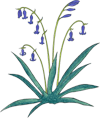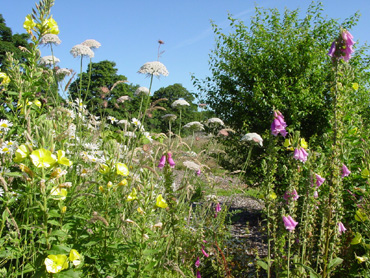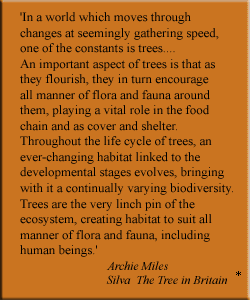


Wildflowers at Brocklands
To create a wood on an open space such as this farmland is a long term process, which is more a case of evolution than creation. The main tree planting does not take place all at once, but rather as the burials occur, which may well be over a period of decades. Consequently the ecology of such a site will require a careful and flexible approach to allow for this slow transition.
Initially the area to be used for burials at Brocklands had to be fenced off from grazing animals such as cows and sheep, and tree guards are still needed to provide protection from rabbits for several years. Deer have never been an issue here, even though roe deer are present in the other woods on the estate but if it does become a problem then deer fencing would have to be considered. The trees are arranged according to height on 3 main areas of the site, with an increasing area of ground given for the larger trees. The trees are grouped in what will become copses, with paths winding around the site so that people can wander along looking at the different berries, leaves and flowers, or stop to admire the view from strategically placed benches.
Elsewhere on the estate, we have commercial woodlands where trees are planted according to strict plans for a main crop (often oak) surrounded by a sheltering 'nursery crop' of softwoods. These nursery crops are thinned after 20 or so years and the timber used for fencing or other practical uses. The main 'crop' of say, oak, will have been encouraged to grow tall and straight, with few branches, so that the wood is strong and desirable for more prestigious uses such as furniture, flooring or green oak beams. Alternatively, in the park at Cappleside, trees have been planted over the generations singly or in twos, with tens of metres between them so that they can grow tall and broad as parkland trees are designed to do. These 2 methods of tree planting are completely different as they have completely different objectives in mind.

Although the newer trees are necessarily surrounded by grass, all new graves are cleared of grass and woodchipped at the time of burial. This not only gives the trees a better chance to establish by reducing competition from grass, but helps to make the soil poorer, too. As the first trees are now over 10 years old, they have become established to the extent that in one corner of the site you can actually walk under the canopy. This area now gives the visitor a good idea of what the rest of the site will become in future years. Under this area of canopy, the conditions on the ground have changed:
 grass is no longer a problem and is sparse,and wild flowers such as bluebells and primroses can grow.
Around Brocklands, bluebells are a significant and dazzling feature
of our woodlands, and so we have not only chosen them for the Brocklands logo, but we encourage
their development over the whole site. Shade-tolerant mosses, ferns and the all-important fungi will also
start to grow - in fact there are several large tree butts on the site which have already got some fine
fungal displays on them.
These variations in flora should then attract more fauna: insects, birds, small mammals and so on.
As the trees grow larger they become habitats themselves. The wood and bark of the trunk provide
food for insects, which in turn provide food for birds such as woodpeckers and tree creepers. The
branches have already become perches and nesting sites for birds, and the foliage gives shade and shelter from
the elements.
Eventually a whole separate world will evolve within this wood, which will support a range of wildlife,
some of which will spend their entire existence in it, while others will use it as their larder, or
sleeping quarters, or maybe as a place to hide.
grass is no longer a problem and is sparse,and wild flowers such as bluebells and primroses can grow.
Around Brocklands, bluebells are a significant and dazzling feature
of our woodlands, and so we have not only chosen them for the Brocklands logo, but we encourage
their development over the whole site. Shade-tolerant mosses, ferns and the all-important fungi will also
start to grow - in fact there are several large tree butts on the site which have already got some fine
fungal displays on them.
These variations in flora should then attract more fauna: insects, birds, small mammals and so on.
As the trees grow larger they become habitats themselves. The wood and bark of the trunk provide
food for insects, which in turn provide food for birds such as woodpeckers and tree creepers. The
branches have already become perches and nesting sites for birds, and the foliage gives shade and shelter from
the elements.
Eventually a whole separate world will evolve within this wood, which will support a range of wildlife,
some of which will spend their entire existence in it, while others will use it as their larder, or
sleeping quarters, or maybe as a place to hide.